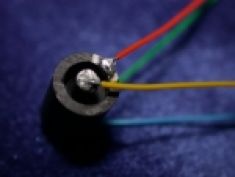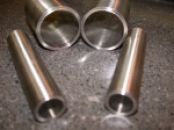SOLUTIONS & SERVICES
Solutions & Services
Sensors Bonding

S-Bond is used in aluminum bonding, ceramic metal bonding, joining all metals, most ceramics, carbon, carbides, and semiconductors. With its ability to wet and adhere to a wide range of materials, S-Bond is an excellent process to assemble and bond sensors and sensor housings.
Applications include the sensor leads, PZT active elements and seals for windows and enclosures. In one sensor application, see in the image to the left, rluxless joining of electrical signal leads to sensor elements with twisted copper leads are bonded to graphite. In another application active ceramic elements (Silcon or PZT) to make conductivity or strain sensors.
S-Bond joins metal composites, bimetallics, ceramic-metals, active ceramic and passive ceramic elements. The range of S-Bond alloys permits the assembly of many sensor types for measuring stress, strain, temperature, pressure, IR, radiation, and others. S-Bond can join silicon to metals and ceramics as a sensor for measuring deflection in applications such as strain and pressure transducers. S-Bond also successfully joins many piezo-electrical materials such as Barium Titanate, Bismuth Ferrite Lanthanum Gallium Silicate, Lead Scandium Tantalite and Lead Zirconate Titanate (PZT), making effective active ceramic sensor components.
Many sensors need to be enclosed for protection. S-Bond joints are hermetic and can bond a wide range of dissimilar metals, ceramics, and glass that are typically used in enclosures or housings. Some examples of housings include the bonding of sapphire windows to thin walled titanium tubes. These assemblies are joined by S-Bond at 250ºC to lower assembly-related distortion and produce a robust, hermetic seal. S-Bond uses lower joining temperatures; the resultant compliant solder interface makes these joints more stable and reliable.

S-Bond is being used to join a range of sensor/optical windows as seen to the left where quartz or sapphire are joined to Kovar® or other metallic frame materials. S-Bond has the capability to join to a wide range of UV and IR inorganic crystal windows, such as ZnSe, BaF2 and LiF.
These window assemblies are typically brazed or conventionally soldered after a metallization is first placed on the edge of the window and the metallic housing. These metallization processes are either vacuum vapor deposited or are sintered, using a Mo-Mn deposition followed by a Ni-plating to produce an adherent, metallic layer that solders or braze filler metals can adhere to. S-Bond can, in one step, metallize and later join the ceramic lenses to the metallic frames or enclosures at temperatures lower than brazing, thus minimizing distortion, which is especially useful when making larger sensor housings and windows.
Contact Us about your sensor or sensor bonding applications and let us engineer an S-Bond solution for you.
View our Technology & Applications White Papers and our Blog for more information.
More Information?
If you would like someone to contact you or provide information, please submit the information to the right.
